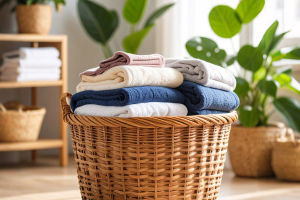We all know that cotton is the fluffy material in our clothes, towels, and sheets. But how does cotton actually grow? It's a fascinating process that starts with a tiny seed and ends with the cotton we use every day.
Let's take a closer look at how cotton plants develop from the ground up.
The Cotton Seed: The Start of It All
It all begins with a cotton seed. Cotton seeds are small, round, and have a hard outer shell that protects the delicate inner part of the seed. Farmers plant these seeds in warm, well-drained soil. The seed needs both warmth and moisture to begin its journey. When the conditions are right, the seed starts to sprout, and a tiny root begins to grow downward, while the stem and leaves push upward toward the surface. This marks the beginning of the cotton plant's growth.
The Cotton Plant Grows Up
Once the cotton plant emerges from the soil, it begins to grow rapidly, especially when temperatures are warm and the plant gets plenty of sunlight. Cotton plants are tall, sturdy plants that can reach heights of 3 to 6 feet (about 1 to 2 meters). Over time, the plant develops leaves and branches, and soon enough, small yellow flowers appear. These flowers play an important role in the cotton growing process.
Flowers Turn Into Cotton Bolls
After the cotton plant flowers, the next step in the process begins. The flowers, which start out yellow, eventually turn a pinkish color before fading to white. Once they have faded, the flowers fall off, and what's left is the cotton boll. The cotton boll is a rounded, pod-like structure that contains the cotton fibers we recognize. Inside, the boll houses soft, white cotton fibers that have been growing within the flower for several weeks.
The Cotton Boll Opens
The cotton boll continues to grow, and eventually, it opens up, revealing the soft, fluffy cotton fibers inside. The fibers are attached to the cotton seeds, creating the cotton balls we're familiar with. This process is called "opening," and it's when the cotton plant is ready for harvesting. As the cotton boll opens, it almost looks like a flower blooming in reverse. The fluffy cotton is now ready to be collected.
Harvesting Cotton
Cotton is usually harvested in the late summer or early fall. Farmers can pick cotton by hand, but in many modern cotton farms, machines are used to speed up the process. These machines are designed to pull the cotton fibers from the plants without damaging the seeds. Once harvested, the cotton fibers go through a cleaning process to remove any seeds, dirt, and debris.
From Cotton to Fabric
After the cotton is cleaned and sorted, it's ready for processing. The cotton fibers are spun into yarn, which is then woven into fabric. This fabric can be used to make everything from clothes to towels, sheets, and even medical supplies. The journey from seed to fabric is a long one, but it's amazing to think about how something so small can turn into the material we use every day.
The Importance of Cotton in Our Lives
Cotton is more than just a fabric. It's a key part of our daily lives. From the clothes we wear to the sheets we sleep on, cotton plays a big role in our comfort and lifestyle. It's a renewable resource, and with proper care, cotton can be grown again and again.
So, the next time you pull on a cotton t-shirt or wrap yourself in a soft cotton towel, remember the fascinating journey it took—from a tiny seed to the fluffy cotton we rely on. Isn't nature amazing?
Now that you know how cotton grows, how will you appreciate the process next time you use it? Feel free to share your thoughts with us!


